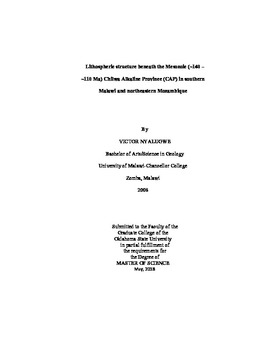| dc.contributor.advisor | Abdelsalam, Mohamed G. | |
| dc.contributor.author | Nyalugwe, Victor | |
| dc.date.accessioned | 2019-05-08T18:36:47Z | |
| dc.date.available | 2019-05-08T18:36:47Z | |
| dc.date.issued | 2018-05-01 | |
| dc.identifier.uri | https://hdl.handle.net/11244/319616 | |
| dc.description.abstract | This work investigates the lithospheric structure beneath the Mesozoic (~140 - ~110 Ma) Chilwa Alkaline Province (CAP) in southern Malawi and northeastern Mozambique using aeromagnetic and satellite gravity data (the World Gravity Model 2012 (WGM 2012). The CAP is a granite, syenite, nepheline syenite, and basanite province with minor intrusions of carbonatite bodies. It intrudes the Precambrian terranes of the Southern Irumide belt and the Unango complex. It is located on the northeastern margin of the Mesozoic Shire graben and on the southeastern edge of the Cenozoic Malawi rift, which is considered the southernmost segment of the Western Branch of the East African Rift System (EARS). Some of the CAP's intrusive bodies are clearly offset by the border normal faults of the Malawi rift. Previous petrographic, geochemical and isotopic studies have suggested that the CAP is underlain by a thinned sub-continental lithospheric mantle (SCLM) possibly due to the Mesozoic Karoo rifting event. Hence, mantle magmatic source has been favored as an origin for the CAP. However, melting of a thickened continental crust cannot be ruled out for the origin of the CAP as has been suggested for several other alkaline intrusions. In this study: (1) Edge enhancement of the aeromagnetic data showed the CAP to be defined by circular and overlapping magnetic anomalies typical of hypabyssal nested igneous ring complexes. (2) Three-dimensional (3D) Voxi modeling and magnetic susceptibility analysis of the aeromagnetic data covering selected CAP's intrusive bodies showed that these were emplaced at an average depth of ~ 4 km. (3) Upward continuation of the WGM 2012 Bouguer gravity anomalies suggested that the CAP was sourced from possibly deeper magma chambers now preserved as broad batholiths at ~4 km to~6 km depth. (4) Two-dimensional (2D) radially-averaged power spectral analysis of the WGM 2012 Bouguer gravity anomalies showed that the CAP is underlain by a thick crust (possibly due to mafic magmatic under-platting) where the Moho can be as deep as ~45 km. It also showed that the CAP is underlain by a relatively thin SCLM (possibly due to Mesozoic Karoo rift-related lithospheric stretching) where the asthenosphere-lithosphere boundary (LAB) can be as shallow as ~110 km. This work suggests that thinning of the SCLM might have allowed for the ascendance and decompression melting of the asthenosphere but also provided heat source (through mafic magmatic under-platting) to partially melt the lower crust to form the CAP from a mixed magma source and through caldera collapse mechanism. This model can be tested by additional geochemical and isotopic studies. This work highlights the importance of potential field data for imaging complex continental lithospheric structure. Understanding the lithospheric structure beneath the CAP is helpful in guiding future mineral exploration efforts because igneous ring complexes are important sites for the formation of economic mineralization zones. | |
| dc.format | application/pdf | |
| dc.language | en_US | |
| dc.rights | Copyright is held by the author who has granted the Oklahoma State University Library the non-exclusive right to share this material in its institutional repository. Contact Digital Library Services at lib-dls@okstate.edu or 405-744-9161 for the permission policy on the use, reproduction or distribution of this material. | |
| dc.title | Lithospheric Structure Beneath the Mesozoic (~140 - ~110 MA) Chilwa Alkaline Province (Cap) in Southern Malawi and Northeastern Mozambique | |
| dc.contributor.committeeMember | Atekwana, Estella A. | |
| dc.contributor.committeeMember | Pashin, Jack C. | |
| osu.filename | Nyalugwe_okstate_0664M_15811.pdf | |
| osu.accesstype | Open Access | |
| dc.description.department | Geology | |
| dc.type.genre | Thesis | |
| dc.type.material | Text | |
